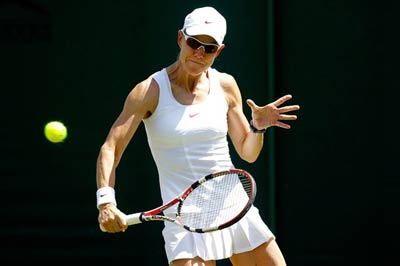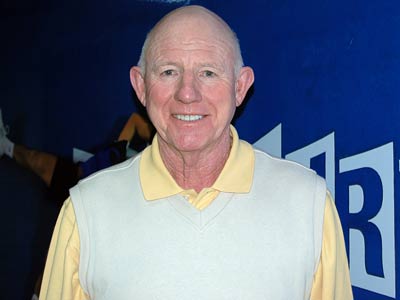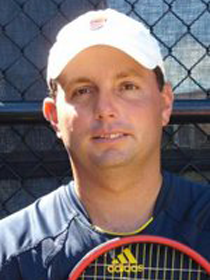|
TennisOne Lessons The Forehand Volley Tom Downs A lot of my coaching on the professional tour has consisted of working with some of the worlds best doubles players. I have been fortunate enough to spend a lot of time working with Rennae Stubbs and the information I gathered about volleys was revealing.
Rennae was coached by one of Australia's best ever developmental and tour coaches, Ray Ruffels, during her formative years. In addition, Rennae is widely regarded as one of the best volleyers tennis has ever seen. A winner of six grand slams, Rennae has always been a tremendous student of the game, and someone who has learned a lot through her own experiences during her years as a touring pro. The many things I learned during my time with Rennae, as well the information I already had about volleys, can help players of all levels improve their forehand volley. I have selected five important things from my experiences regarding the forehand volley, that will help you gain an edge on your club level competition. Grip Lets start with the grip. Yes, I know that most of you are probably thinking true continental grip. But many of the great volleyers use a weak continental grip, which means the base knuckle of the hitting hand is further towards the eastern forehand grip. Interestingly, Par Rafter uses this grip, and didn't even acknowledge it in some recent videos I've watched of him.
This grip allows players to get a little more underspin on their lower volleys. So basically, you don't have to have a true continental grip. Your grip just has to be in the parameters of continental. Also, a lot of the great volleyers use slightly different grips for forehand and backhand volleys. Set the Racquet Correctly There is a very slight turn on the forehand volley. I often see club level players take these huge turns and find themselves so far turned they often hit volleys late (behind their bodies) and cannot get as much body weight transferred into the ball. The unit turn on the forehand volley isn't like the one you would make on a groundstroke, or a backhand volley. After the initial split step, you should pivot the outside foot as you set the racquet. While doing this, your body will turn slightly.
A great drill for working on setting the racquet correctly, as well as eliminating a large takeback, is to stand under the gate entrance to the court you practice on. Have your playing partner toss you a ball to your forehand volley side. You need to volley the ball back to your partner. If you take a huge swing, your racquet will hit the fence next to the gate.
Eyes Level With the Ball All the great volleyers talk about the importance of getting the eyes level with the ball for every volley. Rennae Stubbs took that a step further. Literally on every volley she hit, Rennae would focus on keeping her eyes level with the ball for an extra second thru the contact zone. She would make herself count that extra second on every volley she hit in practice and would focus on this cue in pressure situations in matches. This kept her from lifting off her volleys, which is a common mistake club players of all levels make. You can even see this at the professional level as well. Keeping the eyes level for an extra second thru the impact zone will help you get good body weight going into your volley. Split Step and Stances In today's game, a lot of volleys are hit from different types of open stances. This is due to the power that exists in the modern game, and it means that players don't have to generate pace when volleying.but their body weight should be always going forwards.
For elite level club players, I recommend volleying with open stances when it is needed. For all club level players, I emphasize the importance of the split step and the two steps that should follow. In the case of the forehand volley, a player should split and then pivot their outside foot as they set the racquet. This is the first step. The second step is stepping forward with the front foot as the you swing. I believe in volleying with some sort of open stance, as well as neutral stances when possible, but the front foot has to be stepping forwards, and not across the body. A lot of the great volleyers, such as Pat Rafter, talk about the power in the volley coming from the second step with the front foot after pushing off the outside leg.
On the forward part of the volley, an important thing to focus on is the palm of your hitting hand to travel toward the hitting target. For a crosscourt volley, players should focus on hitting the outside part of the ball and the palm of the hitting hand must go in this direction. For down the line volleys, players must hit the inside part of the ball, and the palm of the hitting hand must go in this direction. Regardless of where you intend to hit your volley, during the forward swing, the outside edge of the racquet will move in an inwards direction.
I believe that there is some wrist in volleys through the contact zone. All club players could benefit from a drill that I learned from Ray Ruffels. Ray would have his players set their racquets correctly, then he would grab the throat of their racquets with his hand. He would then tell them to shadow swing the forward part, while he was still holding the racquet at the throat. Players could then feel the forearm muscles working, as well as some wrist, against Ray's resistant hand. This drill shows that there is some wrist in volleys, as there is a kinetic link between the forearm muscles and the wrist. Is it realistic to volley as well as Rennae Stubbs and other elite level volleyers who have won grand slams? No it is not, but the idea is to become the best volleyer you can be. I can assure you that the lessons you learn from the best the best players in the world, as well as by studying the pro's, will give you the best chance of achieving success.
Your comments are welcome. Let us know what you think about Tom Downs' article by emailing us here at TennisOne.
Tom has and extensive coaching background, and has been a member of the Institute team for several years. He has served as our Head Staff Professional, and is currently the Traveling Coach for Institute players. He has traveled with several of our Tour players including Laura Granville and Carly Gullickson, who won the US Open Mixed Doubles title in 2009. Tom has worked with junior and other professional players, including Sam Stosur and Rennae Stubbs, at all 4 Grand Slam events, as well as other major tournaments around the world. Tom graduated from the University of South Florida in 2005 with a degree in communications. As a successful junior player, Tom represented Australia, and was consistently ranked in the top 10 in all age groups in Australia. He played college tennis at South Carolina State University and was a member of their conference championship team in 2004. |


 Tom Downs
Tom Downs